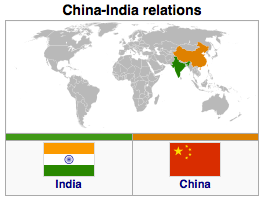Navies And International Diplomacy: The Case Of China And India – Analysis
By IPCS
By Kamlesh Kumar Agnihotri
Two interesting events of maritime significance were reported in the Indian media in May 2012. The first report related to the Chinese Navy’s training vessel Zheng He calling on at India’s Kochi Port on 9 May 12 for a four-day good will visit and second, the announcement of a long-range operational deployment (LROD) of four warships of India’s Visakhapatnam-based Eastern Naval Command to the Western Pacific Ocean, scheduled to commence in mid-May 2012.

The Zheng He training ship, with more than 300 sailors and students from the Dalian Naval Academy on board is on a voyage around the world that includes port visits to 14 countries. Kochi visit is the third leg of the ship’s voyage. On the other hand, the Indian warships comprising missile destroyer Rana, stealth frigate Shivalik, missile corvette Karmuk and fleet tanker Shakti were scheduled to visit ports in Indonesia, Malaysia, Singapore, the Philippines, Vietnam, China and Japan and also engage in the first India-Japan bilateral maritime exercises there.
The striking similarity quite evident from these two activities is that the voyage of the PLA Navy training ship takes it across the Indian Ocean with a visit to an Indian port, while the Indian naval ships’ transit though the South and East China Seas, with a ‘call on’ thrown in at a Chinese port. But such is the nature, charter and special role of the navies as ‘absolutely acceptable and legitimate’ propagators of ‘peaceful diplomacy’ the world over.
In context of the current world order, it is considered that the occasions and opportunities for using Navies in their conventional role of war fighting are few and far between. However there are numerous opportunities for engaging in non-traditional activities which project the benign face of the State whilst keeping the force well trained, equipped and operationally active.
One of the least intrusive, most benign and reasonably effective roles of the navies involves the ‘overseas deployment’ and ‘showing the Flag’ visits to the port of foreign countries. Overseas deployment refers to a task wherein maritime forces are deployed far from own shores, to areas of operational or political interest, so as to gather operational and environmental knowledge; build defence and political relations; develop interoperability; project own reach and capability; and portray national interest. ‘Showing the Flag’ in foreign ports helps to foster good relations, and also affords additional opportunities for interaction at several levels and to develop upon existing relations.
Significance of the ongoing Voyages of Indian and Chinese Warships
The position of the Indian ships as on 15 June 2012 lay at Shanghai port of China. The ships were on return passage after having concluded India-Japan bilateral maritime exercise ‘JIMEX 12’ on 9 June 2012. Concurrently, the ‘Zheng He’ was in Cadiz Port of Spain, preparing for the Atlantic crossing, after having visited Djibouti, crossed the Suez into the Mediterranean and called on the Italian port of Taranto. Both Countries’ naval ships have a long voyage ahead.
In context of the current complex maritime dynamics in the Western Pacific, particularly in the South China Sea, this overseas deployment should send out a message of India as a ‘major stake holder’, striving for peace, stability and ‘freedom of seas’ in the region. While the port calls at Subic Bay, Hai Phong, Tokyo and subsequent joint exercise with the JMSDF showcased the Indian goodwill, friendship and congruence of interests, the visit to Shanghai demonstrated that India, at the same time, seeks greater interaction with China, militarily and politically. The Commander-in-Chief of the Indian Eastern Naval Command was reported to have stated on the occasion that “…friendship and cooperation between the Chinese and the Indian Navy was growing every year… ”
Similar sentiments were expressed by the Senior Officer accompanying the Zheng He at Kochi. He averred that “…the main purpose of the visit was to strengthen the friendship and cooperation between the two countries and the two navies…”
Notwithstanding the difference in the mission profile of the two countries’ ships, there can be no denying the fact that Delhi is serious about broadening the ‘Look East’ paradigm to ‘Act East’, while Beijing strives to maintain its visible presence in the Indian Ocean. In this individual pursuit, it should be to the benefit of both the sides if friendly and cooperative relations – particularly between the two navies – in a peaceful and stable environment are maintained.
Kamlesh Kumar Agnihotri
Research Fellow, China Cell, National Maritime Foundation
email: [email protected]
